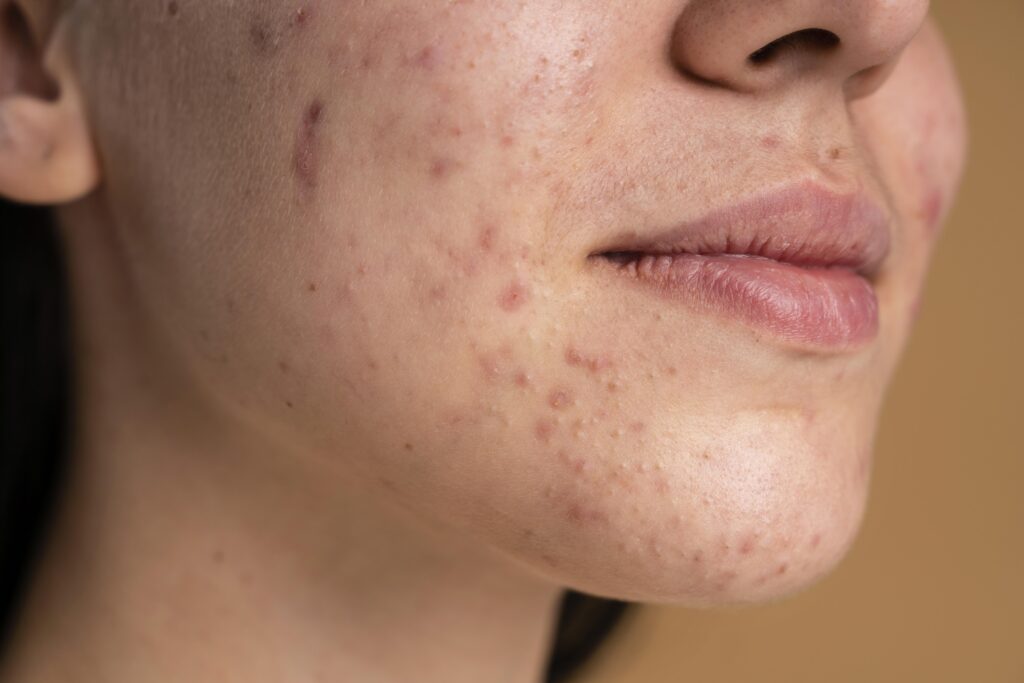Blackheads, commonly referred to as comedones, are skin lesions that consist of a mixture of sebum, sweat, dirt, and keratinized epidermal cells that accumulate in enlarged pores. The characteristic black dots on the nose and other areas of the face (known as open comedones) form when the outlets of the sebaceous glands near hair follicles become clogged. They can also manifest as white lumps filled with thick content, referred to as closed comedones.
While blackheads are often on the nose, they can also appear on the forehead, chin, cheeks, and even the back. The overproduction of sebum makes clogged pores and blackheads particularly prevalent in individuals with oily skin. However, they can also occur in those with dry and sensitive skin.
In addition to excessive sebum production, blackheads can arise from the improper structure of skin pores. Poor skincare practices, such as insufficient hydration of the epidermis, can also contribute to their formation. Dry facial skin prompts the sebaceous glands to work more intensely. Additionally, a lack of regular cleansing and exfoliation can lead to clogged pores. That is because these treatments help unblock the pores and normalize gland function.
To effectively remove blackheads at home, it is essential to change daily hygiene habits.

The name comedonal acne comes from the presence of small lesions on the skin—comedones. These are non-inflammatory skin eruptions, which are also referred to as primary eruptions, mainly because they are one of the first symptoms of comedonal acne.
Although comedones are commonly referred to as blackheads, not everyone realizes that in reality, we can distinguish two types: open comedones and closed comedones. How do they vary from each other?
Open comedones are the ones we call blackheads. In their structure, they have a microscopic opening through which excess sebum and keratinized epidermis escape to the outside. The characteristic dark color is the result of oxidizing keratin and melanin accumulating in the pores.
Closed comedones are the result of the accumulation of corneocytes (dead skin cells) in the sebaceous glands. They take the form of tiny, white lumps, which often become palpable and noticeable only after stretching the skin.
Comedones are non-inflammatory, small subcutaneous nodules that form when hair follicles, or skin pores, become blocked by sebum, dead skin cells, and dirt. Because they are located deeper within the skin and do not have access to air, closed comedones appear as white lumps beneath the surface.
Closed comedones are primarily caused by excessive sebum production from the sebaceous glands. Their formation is also influenced by irregular pore structures and disrupted exfoliation processes of epidermal cells. Additionally, blackheads on the face can often result from improper skincare routines and poorly selected cosmetics, particularly those with comedogenic properties that clog pores.
People with oily or combination skin are most generally impacted by closed comedones. These blemishes typically emerge in the so-called T-zone, which includes the nose, forehead, and chin, but they can also appear on the back or chest.
Sebum is an oily substance created by the sebaceous glands that helps maintain moisturized skin. When overproduced, it combines with dead skin cells and environmental pollutants to clog hair follicles and produce conditions conducive to bacterial growth. The buildup of bacteria can cause hair follicles to swell, leading to blackheads.
Hormonal fluctuations, often associated with puberty, menstruation, pregnancy, or menopause, can improve sebum production, which can boost the formation of blackheads.
The presence of acne-causing bacteria (Propionibacterium acnes) in clogged pores can induce inflammation, leading to the formation of blackheads.
Some makeup and skincare products contain comedogenic ingredients that can block pores and contribute to the formation of blackheads, particularly if used in excessive amounts.
A higher intake of refined carbohydrates and dairy products contributes to acne, which can worsen blackheads in some people.
Smoking and high levels of stress may negatively influence skin health and worsen acne symptoms, including whiteheads.
A family history of acne can make a person more susceptible to blackheads and other types of acne.
Pollution, moisture, and certain climates can harm your skin and lead to blackheads, especially for sensitive skin.
Touching, squeezing, or applying pressure to the skin may spread bacteria and worsen blackheads. It is necessary to avoid irritating them.
Doing skin care regularly is essential for good skin.
During daily cleansing treatments, you need to help your skin give its all, regenerate, and renew better. Facial cleansing treatments constitute more than half of the success in daily care.
Effective skin cleansing is just three steps, and those are:
Never go to bed without thoroughly washing off make-up from her face. Properly done, it is intended to remove the layer of makeup mixed with sweat, sebum, and dust. Thanks to this, the skin can fully absorb the active ingredients provided in the care cream.
Dry skin ages faster, so all wrinkles are more visible. Therefore, opt for an effective moisturizing cream.
If the feeling of tightness on the skin continues despite the moisturizing cream, it is the moment to reach for more concentrated cosmetics. Go for serum. In synergy (serum and cream) they work much more intensively, often allowing for faster and more effective improvement of the skin condition. After thoroughly cleansing and toning the skin of the face, gently pat in a moisturizing serum and only then apply the cream.
The sun intensifies photoaging. Sun protection is crucial to healthy skin. UV cream is useful all year round.

Professional treatments that effectively remove excess dead skin and cleanse pores can be a great solution for skin issues. These treatments include microdermabrasion, cavitation peeling, and chemical peeling. Although these treatments are currently very popular, remember not to do them on your own but to use the services of professionals.
If we have been struggling with blackheads and other facial imperfections for some time, it is a good idea to consider visiting a dermatologist. They will carefully look at any skin changes and order the necessary tests. It is possible that a specialist preparation for blackheads will be prescribed, especially if they are the result of acne. They are usually based on active substances such as retinol or azelaic acid. You shouldn't use such ingredients on your own because their effect is strong, so it may be challenging to adjust their proper concentration and frequency of application on your own.
Additionally, both in a dermatologist's and a cosmetologist's office, you can decide on selected treatments that combat acne and all imperfections. To effectively remove closed and open blackheads, a consultation will be essential to choose the right method. Microdermabrasion, which involves chemical exfoliation of the epidermis and pore cleansing, is particularly popular and has been shown to be highly effective in reducing pimples.
Even an experienced and trusted dermatologist or cosmetologist cannot eliminate imperfections on our face – whether they are white comedones, blackheads, or more serious pimples – if we do not pay attention to our lifestyle. Decreasing the factors that directly affect the deterioration of the skin's condition is one of the key actions we can take to reduce skin changes to a minimum.
A significant element is certainly a change in diet. It should have a variety of vegetables and fruits, including berries, green tea, groats, nuts, and olive oil. Choose whole grain products rich in nutrients, and ensure that the fat in the diet comes from good plant sources. If necessary, take additional supplements.
The right amount of sleep is also key; an adult should sleep about 7 hours daily. Contrary to appearances, a regular sleep pattern is largely reflected in the appearance of our skin.
Many people wonder how to cleanse their faces of clogged pores, but it's significant to know that completely closing them is not possible. Clogged pores on the chin, forehead, or other face features can be very bothersome. First, the skin does not look very good at first glance. Closed or open blackheads remain visible even when we apply color cosmetics to the face. However, there is no one proven way to deal with clogged pores. It is worth starting here by recognizing the needs of your skin. Also, it is worth finding out what, for example, causes the overproduction of sebum. It is necessary to eliminate the problem at the source because a one-time cleansing of pores is usually ineffective.
If you are wondering how to unclog pores, remember that it is not always necessary to use professional cosmetic treatments. Equally good results can be achieved by regular cleansing of the face. Consistent care is key to improving skin imperfections, making regularity essential for effective results.
People who complain about clogged pores on the cheeks, nose, or chin should take a closer look at their daily skin care. It is extremely important because clogged pores on the nose or other parts of the skin are very often a problem associated with leaving remnants of makeup or other impurities on the skin.
In this case, it is worth reaching for cosmetics such as micellar fluids, makeup removers, cleansing butter, foams, or cleansing gels.
If excessive dryness occurs, it means that the individual cosmetics were not properly matched to the needs of the skin or, for example, the routine lacked facial toner.
Clogged pores on the forehead, cheeks, or chin are often caused by using the wrong color cosmetics, as some products can be comedogenic. If you have oily skin, it is crucial to select light, non-clogging foundations, such as BB or CC creams. It is particularly important if your skin has blackheads or inflammation.
To cleanse the skin effectively, it is recommended to treat the pores on the face with, for example, steam. In this circumstance, we do not necessarily have to use professional devices such as a steamer. All you need is a bowl of warm water. This is a good introduction to multi-stage cleansing. It will work for both dry and any other skin. Pores enlarged in this way are much easier to care for.
How to properly cleanse the pores on the face? It is worth starting with exfoliators. Such products work great for both open and closed comedones. They are indispensable in weekly skin cleansing (we use them less often when our skin is particularly sensitive). People who struggle with clogged pores will quickly notice the difference if they reach for an exfoliator tailored to the needs of their skin several times. Enzymatic or possibly fine-grained cosmetics are most often recommended.

Although each of us has our own habits and ways of caring for our facial skin, there are some behaviors that are not good for any skin type. Sometimes using them is due to ignorance, sometimes they are simply not properly selected for the type of skin we have. Check if you are not making any of these skin care mistakes.
Proper care for each face begins at the store shelves. Sometimes facial skin problems result from inappropriate purchasing decisions. A cosmetic poorly selected for the type and age of the skin can even intensify existing problems. Where do these mistakes come from? Often from ignorance – for example, having dry skin on the body, some people assume that they also have dry skin, but it does not have to be that way! To check what type of skin you have, you can of course go to a dermatologist, but there are also other ways. One of them is to simply carefully observe the skin of your face and compare it with the characteristic features that are assigned to specific types.
Another mistake and an example of how not to take care of your skin is not using face creams with a filter. Harmful UVA and UVB radiation reach the skin of your face constantly, even on a cloudy day – not only during a summer vacation on the beach. That is why you should protect your skin by using products with an appropriately high filter. Sun rays cause so-called photoaging of the skin, which results in deepening wrinkles, not to mention accelerating the drying of the skin.
You discover them in the morning and they spoil your mood for the whole day. They look unsightly, and sometimes they hurt. You decide to get rid of them quickly and start squeezing. But this method of dealing with pimples or blackheads can do more harm than good. Squeezing involves a lot of pressure on the skin, stretching it, and rubbing it, which is quite a challenge for the skin. When squeezing, you can spread bacteria to other areas of your face, which is also irritated and red after such a procedure. How to care for a face with imperfections? It is best to focus on regular exfoliation and deep cleansing. Although the causes of pimples are different, clean skin is the first step in combating this type of change.
If you are struggling with acne, it is obvious that you should consult a specialist.
Both in adolescence and in adulthood, people affected by acne consult doctors and dermatologists much more often than in the past. And this is not only in the case of severe acne, which can cause scarring. Often, a doctor seeing a patient with mild or moderate acne can help him choose a treatment that can prevent its worsening at an early stage. So do not hesitate to visit a dermatologist when the first changes appear.
Regardless of the severity of acne, if you lose your self-confidence and start to create a negative image of yourself in your head or you notice difficulties in relationships with others due to acne changes, even if they are moderate imperfections, you should consult a doctor and share these feelings with him.
Acne is sometimes responsible for the appearance of depression, so we will repeat once again that an early visit to a dermatologist and starting acne treatment can prevent its recurrence and help improve your self-image.
Table of Contents